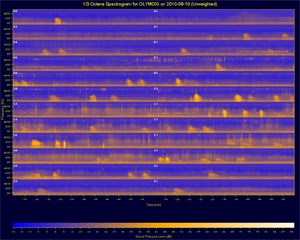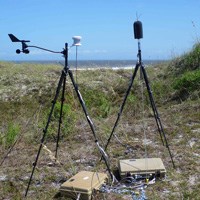Several types of data are needed to accurately quantify the acoustic environment of a park.

NPS Photo
Describing the acoustic environment.
At each site, monitoring equipment takes sound pressure level and frequency readings. The sound pressure level (loudness) is recorded in decibels (dB) and the frequency (pitch) of a sound is recorded in hertz (Hz). Currently, sound equipment used in the parks can record sounds from 12.5 to 20,000 Hz, which exceeds the human hearing range. High frequency sounds (a cricket chirping) and low frequency sounds (water flowing in a river) often occur simultaneously, so we split the frequency spectrum into 33 smaller ranges, each encompassing one-third of an octave.
For each one-third octave band, dB level is recorded once per second for the duration of the monitoring period. Recording the sound intensity of each one-third octave band (combined with digital audio recordings described below) allows acoustic technicians to determine what types of sounds are contributing to the overall sound pressure level of a site. At sites where the sound pressure levels are very low, it is ideal to monitor with low-noise, high-sensitivity microphones. For some types of analysis, dB levels are A-weighted (dBA) to more closely represent the sensitivity of the human ear to different frequency ranges. (See Understanding Sound for more information on A-weighting).
Sounds are represented visually using a spectrogram, an image that incorporates frequency (y axis), time (x axis), and amplitude (brightness of color).

NPS Photo series

NPS Photo by Emma Brown

NPS Photo by Cecilia White
Last updated: February 18, 2018
